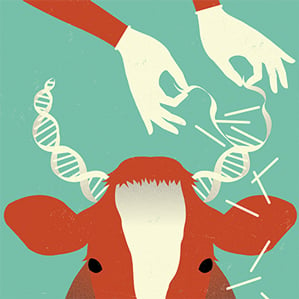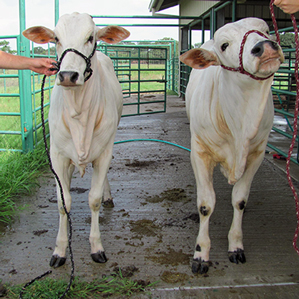On the Horns of the GMO Dilemma
Four years ago, Scott Fahrenkrug saw an ABC News segment about the dehorning of dairy cows, a painful procedure that makes the animals safer to handle. The shaky undercover video showed a black-and-white Holstein heifer moaning and bucking as a farmhand burned off its horns with a hot iron.

Fahrenkrug, a molecular geneticist then at the University of Minnesota, thought he had a way to solve the problem. He could create cows without horns. He could save farmers money. And by eliminating the dairy industry’s most unpleasant secret, he might even score a public relations success for genetic engineering.
The technology Fahrenkrug believes could do all this is called genome editing (see “Genome Surgery” and “Genome Editing”). A fast, precise new way of altering DNA, it’s been sweeping through biotechnology labs. Researchers have used it to change the genes of mice, zebrafish, and monkeys, and it is being tested as a way to treat human diseases like HIV (see “Can Gene Therapy Cure HIV?”).
With livestock, gene editing offers some extraordinary possibilities. At his startup, Recombinetics, located in St. Paul, Minnesota, Fahrenkrug thinks he can create blue-ribbon dairy bulls possessing traits not normally found in those breeds but present in other cattle, such as lack of horns or resistance to particular diseases. Such “molecular breeding,” he says, would achieve the same effects as nature might, only much faster. In short, an animal could be edited to have the very best genes its species can offer.
That could upend the global livestock industry. Companies could patent these animals just as they do genetically modified soybeans or corn. Entrepreneurs are also ready to challenge the U.S. Food and Drug Administration, which has never approved a GMO food animal. They say gene editing shouldn’t be regulated if it’s used to merely swap around traits within a species. “We’re talking about genes that already exist in a species we already eat,” says Fahrenkrug.
The use of the technology remains experimental and far from the food chain. But some large breeding companies are starting to invest. “There may be an opportunity for a different public acceptance dialogue and different regulations,” says Jonathan Lightner, R&D chief of the U.K. company Genus, which is the world’s largest breeder of pigs and cattle and has paid for some of Recombinetics’ laboratory research. “This isn’t a glowing fish. It’s a cow that doesn’t have to have its horns cut off.”
GMO Bust
To date, GMO food animals have been a complete bust. After the first mice genetically engineered with viral DNA appeared in the 1970s, a parade of other modified animals followed, including sheep that grow extra wool thanks to a mouse gene, goats whose udders made spider silk, and salmon that mature twice as quickly as normal. But such transgenics—animals incorporating genes from other species—mostly never made it off experimental farms.
Opponents of genetically modified organisms (GMOs) gathered millions of signatures to stop “frankenfoods,” and the FDA has held off approving such animals as food. AquaBounty Technologies, the company that made the fast-growing transgenic salmon, has spent 18 years and $70 million trying to get the fish cleared. Two years ago, the University of Guelph, in Ontario, euthanized its herd of “enviropigs,” engineered with an E. coli gene so they pooped less phosphorus, after giving up hope of convincing regulators.

Genome editing can also be used to create transgenic animals. But cows edited to be hornless would not have DNA from a different species, just DNA from a different breed of cattle. That is what entrepreneurs hope will create a regulatory loophole. The FDA’s regulations on genetically engineered animals, issued in 2009, didn’t anticipate gene editing and, in Fahrenkrug’s opinion, may not cover it.
In response to questions from MIT Technology Review, the FDA agreed that its rules “addressed the technology at the time.” But the agency says it reserves the right to regulate gene editing, too. “We are carefully considering the appropriate regulatory approach for products made using this technology but have not reached any decisions,” said agency spokeswoman Theresa Eisenman.
To make hornless dairy cows, Fahrenkrug says, he looked up the genetic sequence that naturally causes Angus cattle, a beef variety, to lack horns. Following nature’s no-horns recipe, he used a gene-editing method called TALENs in his lab to introduce it into skin cells from a horned Holstein bull. In total, he deleted 10 DNA letters and, in their place, added 212. Some of those cells were then turned into embryos through cloning and used to impregnate several cows. Fahrenkrug is expecting the first of several hornless calves to be born within a few weeks. He declined to say where they were being kept, citing the risk of sabotage by animal-rights or anti-GMO activists.
Scared to Death
Any genetic tinkering with the food supply could arouse opposition, but Fahrenkrug hopes the vision of a hornless cow could make people see things his way. Animal-rights campaigners hate GMOs. But they hate dehorning more. Farmers do it only because they have to. Douglas Keeth, an investor in Recombinetics, says his great-grandmother was gored to death by a dairy cow. “When I was a young man working on a farm, we’d dehorn cattle with mechanical means. You do 100 steers and, well, it’s a bloody mess,” he says. “You wouldn’t want to show that on TV.”
Although not all cattle have horns, most Holsteins do. According to the Holstein Association USA, all 30 of the top-rated Holstein bulls in the U.S. have horns. Semen from these champion bulls, which are prized for fathering offspring that produce titanic amounts of milk, is frozen and shipped around the globe. After more than a century of selective breeding, the average dairy cow in the U.S. produces 23,000 pounds of milk a year (compared with about 5,000 pounds for an ordinary cow).
With Holsteins smashing milk records, any effort to mix in useful new traits by mating is challenging. That’s because crossing a record milker with a lesser animal will dilute its pedigree, says Lightner, whose company shipped $177 million worth of frozen bull semen last year. It can take several generations of crosses to make a true milk champion again.
Gene editing, by contrast, is fast and precise. Last year, working with the Roslin Institute and Texas A&M University, Fahrenkrug easily created Brazilian Nelore cattle with increased muscle mass. He did that by adding to Nelore embryos a muscle-boosting mutation that occurs naturally in breeds like Belgian Blues, though it had never before been seen in rangy, heat-tolerant Nelores. The edit consists of deleting 11 DNA letters from a single gene, thereby cutting production of a muscle-regulating protein called myostatin. Lightner says such feats are why Genus has started underwriting gene-editing research. “We haven’t realized the opportunity for genetic engineering in animals to any degree,” he says. “But these new approaches that let us move traits around could be transformational.”
Fahrenkrug’s ideas have grabbed the attention of dairy farmers, too. The technology “is very cool,” says Tom Lawlor, head of R&D for the Holstein Association USA. But he says milk producers are afraid of genetic engineering. “The technology definitely looks promising and seems to work, but we would enter into it slowly as opposed to rapidly for fear the consumer would get the wrong idea,” he says. “We get scared to death, because our product is milk, and it’s wholesome.”
Conventional breeding has also become far more precise thanks to DNA tests. By July of this year, an international collaboration calling itself the “1,000 Bull Genomes Project” had decoded the DNA of 234 dairy bulls, including Swiss Fleckviehs, Holsteins, and Jerseys. Breeders can now accurately size up an animal’s genes at birth. One result is that a few hornless bulls are already approaching top-ranked status. That leaves Lawlor unsure if there’s much of a need for gene editing.
Patented Cattle
In January, Fahrenkrug filed a patent application laying claim to any animal whose genes are edited to remove their horns. The threat of cattle patents has alarmed some farmers already distressed by seed patents. “They could take semen from my bull, gene-edit it, patent it, and the farmer will get totally screwed,” says Roy MacGregor, who breeds hornless cattle in Peterborough, Ontario. “They should not be allowed to.”
Anti-GMO campaigners also won’t have to look far for reasons to criticize gene editing. There are easy targets, like a strategy Fahrenkrug conceived to prevent cattle from reaching sexual maturity. That may make it quicker to fatten them for slaughter. It would also allow gene-editing companies to keep selling animals without the risk of “uncontrolled breeding of the animals by the buyers,” as another of Recombinetics’ patent applications puts it.
It’s possible, even probable, that cautious regulators, activists, and commercial challenges will keep products from gene-edited animals off supermarket shelves for years. Maybe forever. But what’s not slowing down is the advance of gene-editing technology. “People will say to me, ‘You realize this changes everything, don’t you?’ Because it does,” says Fahrenkrug. “The genome is information. And this is information technology. We have gone from being able to read the genome to being able to write it.”
Keep Reading
Most Popular
Large language models can do jaw-dropping things. But nobody knows exactly why.
And that's a problem. Figuring it out is one of the biggest scientific puzzles of our time and a crucial step towards controlling more powerful future models.
The problem with plug-in hybrids? Their drivers.
Plug-in hybrids are often sold as a transition to EVs, but new data from Europe shows we’re still underestimating the emissions they produce.
Google DeepMind’s new generative model makes Super Mario–like games from scratch
Genie learns how to control games by watching hours and hours of video. It could help train next-gen robots too.
How scientists traced a mysterious covid case back to six toilets
When wastewater surveillance turns into a hunt for a single infected individual, the ethics get tricky.
Stay connected
Get the latest updates from
MIT Technology Review
Discover special offers, top stories, upcoming events, and more.